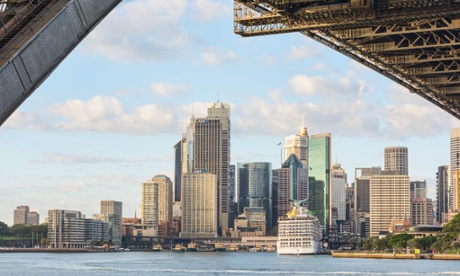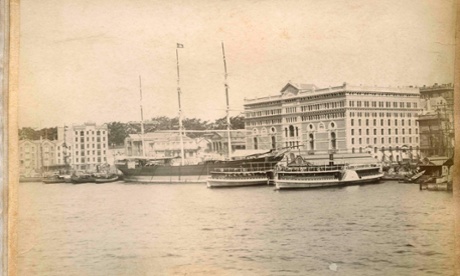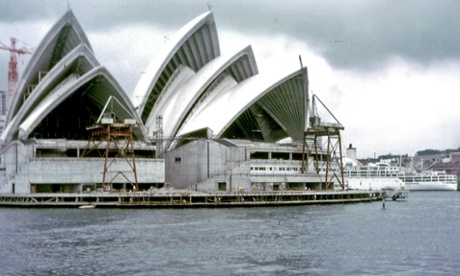Liam Hogan
 |
| 'In Australia, we recognise the natural centres of our urban areas mostly by the fingers of concrete-and-glass business towers.' Photograph: flickr |
If a house is a machine for inhabiting, as Le Corbusier's famous aphorism went, then central business districts are machines for compressing, containing and concentrating an economy. Sydney's CBD, specifically, is a machine for concentrating a very large number of white-collar workers, dominated these days by financial and professional services, and reaping the aggregation effects: get all of those lawyers, accountants, financiers and managers together, close enough to go to the same coffee shops and have cigarette breaks on the same corners, and you've got yourself a powerful economic entity. For better or worse, Sydney's centre is a business park on steroids.
In Australia, we recognise the natural centres of our urban areas mostly by the fingers of concrete-and-glass business towers. Much of that expansion was the product of gut-level politics: what to keep, what to abandon, and why. What we think of as "heritage" in the Sydney CBD is the layered leftovers, everything that for various reasons was never bulldozed, flooded, or remodelled into something "better".
Nostalgia, in Sydney, is for the weak.
The 19th century city started out as a brutal little torture port, crammed with workers and animals. As it grew bigger and got respectable, three things identified its edges: factories, wharves, and cemeteries. Nineteenth century Sydney had a bit of a morbid habit of laying the dead to rest at the urban fringe, then deciding the land was more useful for the living. Sydney Town Hall was built on the old Sydney burial ground. The 19th century central station wasn't exactly located where it is now; its current site used to be the Devonshire Street cemetery. If development had to happen, the past had to make way, even when that past was embodied in human remains. Sydney has been a ruthlessly modern city. Not only has it turned its face from its own European heritage, it has most of all tried to erase the 40,000 years' heritage of its first, Aboriginal, inhabitants.

The results are part of folklore. In the 1960s and 1970s, if you wanted to work in the construction industry, or if you wanted something built, you joined or dealt with the famously militant Builders Labourers Federation (BLF). They were a serious union, a left-wing closed shop which prospered on their ability to get pay rises and stop its members getting killed in preventable accidents.
When a group of residents in the upper-class Hunters Hill asked the BLF in 1971 to help save a piece of bushland from property developers AV Jennings, the real fight started. The union's refusal to work on the site – what has since been called a "green ban" – was taken by the developer as a pretext to go ahead anyway with non-union workers. The BLF threatened to stop work on an AV Jennings office block in North Sydney in response.
There isn't a community campaign anywhere that won't shamelessly compare itself to the green bans movement, which grew throughout the 1970s. In practice, the green bans had a class and union aspect which contemporary urbanists forget about: the BLF was a working-class organisation that merely saw its remit more widely than most unions, figuring that since its members were in the business of demolishing and building, they might as well have a say in what they put up or down – especially when they were talking about working class housing. It was not as though a union simply, one day, saw value in heritage arguments for the preservation of the built environment fabric.
'In practice, the green bans had a class and union aspect which contemporary urbanists forget about: the BLF was a working-class organisation which merely saw its remit more widely than most unions.'
The minister formerly responsible for public housing in NSW, Pru Goward, added a perverse footnote to this history in March when she pushed through the sale of the Millers Point housing estate. She argued that the value of the estate could be best deployed buying more and better housing away from the CBD, and at least in terms of the value she is right: it's the location and preserved heritage aspects of the Millers Point housing stock that make it worth so much money. In this case there's at least a part of the green bans legacy (the valuation of the historical built environment) which is being deployed against the kinds of working class men and women who started it in the first place.
Urbanism abounds in ironies like this. The Burra Charter, the 1979 set of basic heritage principles used by Australian planners and historians, places "cultural heritage" front and centre in the decision making process. It is deliberately, provocatively, broad in its remit: places, not just individual sites, are its objects. A more recent 2011 ICOMOS statement, the Madrid Document, specifically includes 20th century architecture in the context of heritage. The heritage sector isn't about protecting what's profitable, or good for the economy, but rather, that which is intangibly important – and that past starts now.
The 20th century central business district, which was largely designed and constructed in the context of furious, enthusiastic abandonment of the past, is now falling under the protection of legal regimes of heritage. It's being appreciated as worthy fabric too. There's a growing appreciation for brutalism as an architectural style, for example. The old light rail line that people remember running through the Sydney CBD is to come back, though naturally without the central tram depot that used to sit on Fort Macquarie (now the site of the Sydney Opera House, listed by UNESCO as having World Heritage, along with the Pyramids and Taj Mahal).

There are plenty of good reasons why suits and jackets are unsuited to the Australian climate, but air conditioning makes that style of business-uniform dress possible. We've got a historical city of offices which were designed before the Internet, and that architecture tends to determine work practices. What of this kind of accidental heritage demands protection? Is office presenteeist culture part of the cultural fabric of the CBD, worth preserving in place?
We have patterns of commercial land use in which we can read the past. In Australian cities we have long suburban retail strips, developed around 19th and early 20th century tram lines; we have central department stores designed to cater to the new middle class consumers who emerged after the first world war; we have larger developed post-second world war shopping centres attracting car-owning shoppers; and most recently there has been a growth in suburban one-store big box retailers (IKEA and Bunnings being the best examples).
Commercial and residential patterns do change over time, but with some amount of difficulty, and always subject to the past. In Australian inner suburbs, terraces have been turned into shopfronts and bars. What were once inner-city warehouses and factories have become in-demand housing and office space. Developers drawing up skyscraper developments that once might have been sold as offices, suddenly, are relabelling them as apartment housing for a new booming demand for units in the city.
The economy of cities tends to change rather faster than any system of land-use can account. And to a great extent, this was always the point of the concept behind the central business district: that it could be an area governed by the new, forever reinventing itself – modernity, in the famous phrase, melting the solid into air.